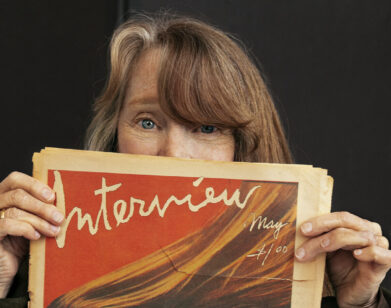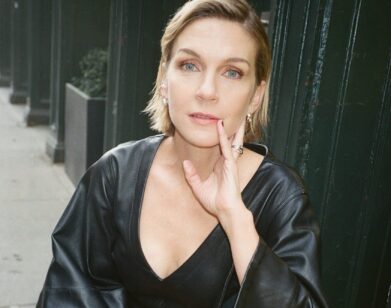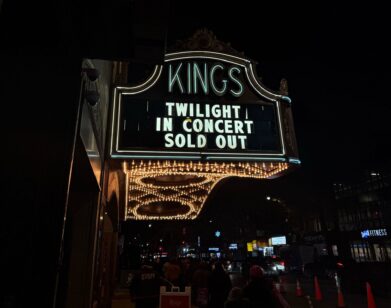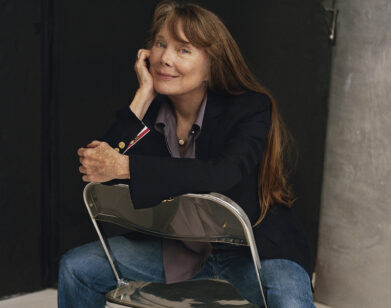Jim Jarmusch’s Poetic Verse
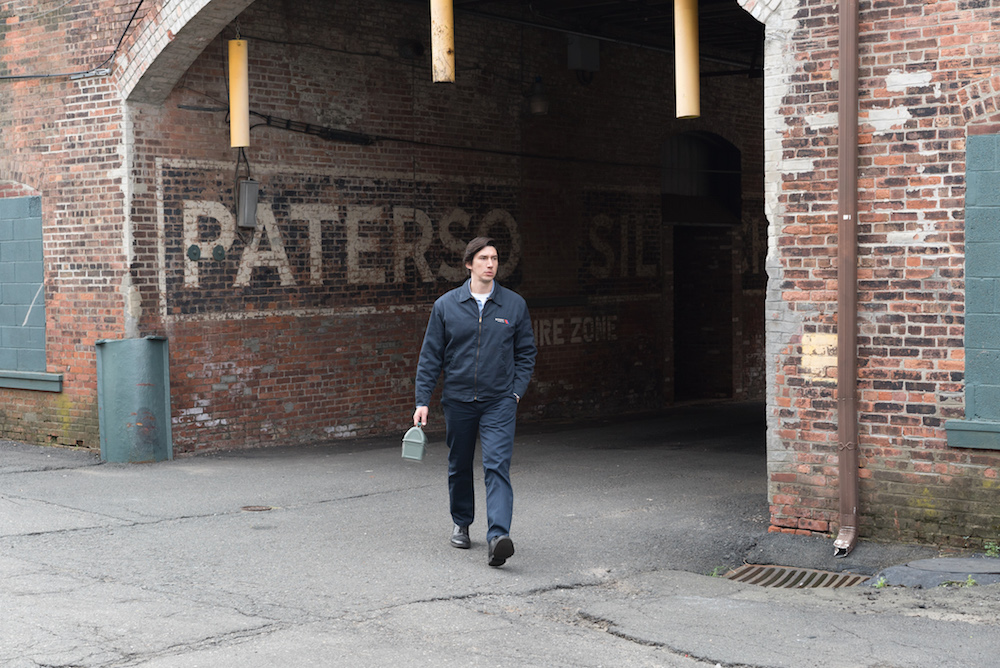
ADAM DRIVER IN PATERSON. PHOTO COURTESY OF MARY CYBULSKI/AMAZON STUDIOS & BLEECKER STREET.
To call Jim Jarmusch‘s latest film, Paterson, spare is not a criticism—the legendary downtown New York filmmaker has crafted a tribute to the seemingly uninteresting details of the quotidian, distilled through the life of a bus driver named Paterson (Adam Driver) living and working in the city of Paterson, New Jersey. Paterson’s life is one of routine: work; dinner with his wife, Laura (Golshifteh Farahani); a walk with their affable bulldog, Marvin; and a drink at the neighborhood bar before bed. And in between, Paterson writes poems, revering the likes of Paterson-native William Carlos Williams and Frank O’Hara. Paterson itself is structured like a poem, the days broken into stanza-like vignettes, the verse flowing freeform. Interview recently spoke with Jarmusch by phone.
COLLEEN KELSEY: In an interview you did at Cannes, you said that the film was, “intentionally slight.” Tell me about the decision to commit to subtly and simplicity.
JIM JARMUSCH: Oh, you know, I don’t know. I’m not overly analytical, and I don’t set out to make something particularly. Part of me wanted to have an antidote to things that are overly dramatic, and the conflict of people and couples and “action,” that kind of thing. Part of me wanted to put the bounce back a little bit towards films that I love, like films by Ozu or Bresson that are not dramatic, particularly. The other part was just my aesthetic, I guess, kind of minimal. I know from the past, critics often say my films don’t have any plot, that kind of thing. I’m used to being told, “Yeah, it’s slow and has no plot.” That’s kind of slight for some people already, but there’s nothing wrong with something being slight in this case. It’s a film that’s observational and quiet.
KELSEY: Right. Well, the “action” in the film is Paterson’s interior thought process or his body moving through time and the day.
JARMUSCH: The whole idea is to appreciate those little things—those small details of life.
KELSEY: So what came first, Paterson, the character, or Paterson, the city? Or William Carlos Williams’s poem?
JARMUSCH: I went to Paterson 20-something years ago for a little day trip, and it was because of William Carlos Williams. I had never been there. So, I went there and I ended up going down by the falls, and sitting, really, in the exact same place where Paterson sits in the film, and I walked around the industrial areas. The opening of his poem, the long poem Paterson by William Carlos Williams, is a metaphor of a man. I think it’s the rock formations above the falls suggested a reclining man, and then he makes the city a metaphor for a man, so that gave me the idea of a guy named Paterson from Paterson. That gave us a working class guy that’s also a poet, and I just carried these little ideas around for a long, long time, and I didn’t end up writing the script until, I think, about six years ago. I wrote the script before I made my previous feature film, Only Lovers Left Alive, but then I had it in my head that after I made Lovers, I was going to make this script into a film.
KELSEY: I also wanted to talk about the repetition of patterns, the structure of the film, and the daily increments broken into stanzas or verse. Repetition is a method you’ve employed before in The Limits of Control. But what about that technique presented itself as a fit for this film?
JARMUSCH: I’m very interested in variations. Making a film that is in seven days of one week is not a new idea. It’s probably obvious, but even the word “mundane” or “quotidian” means daily life. So why don’t we use the simple structure of one week, because Paterson himself, he feels secure, obviously, in a routine. He gets up at the same time, he doesn’t think about what he is going to have to wear, where does he have to be. He knows what his job is. His bus route is the same, and even then he spends time with Laura, and then he takes the dog out and goes to the bar, and everything is set up for him. That allows his mind to wander, and that’s where his poetry comes from: Observing small details. “No ideas but in things.” I love variation in all forms: in painting, in music. I’ve just always been drawn to it, and I think some of my other films reflect that. I’ve used it by making little stories strung together in films. Coffee and Cigarettes [2003] is just a bunch of variations of kind of the same thing. I’ve always been drawn to that. I like repetition, but I really, really like variations, synchronistic things that happen where you’re not really thinking about them. Like the idea of having twins in the film comes from her mentioning a dream, but I didn’t want to end with, “Now she’s pregnant with twins.” I didn’t want those guys to pull up in the car that are talking about dog-jacking, well they’re not gonna jack his dog, they’re just guys that were talking about that. Everything is not laden with potential for drama in life. So, I followed those strategies for the film.
KELSEY: What are the parallels between cinema and poetry for you?
JARMUSCH: I think Paterson is more of a film in the form of a poem rather than a poem in the form of a film, if that makes any sense. Film relates to almost every other form of expression, but poetry is a bit abstract in its strength and sometimes even the white spaces on the page are evocative almost as much as where the text is. Certain poets have played with that. Sometimes I make films about scenes other filmmakers would leave out, so I just make the film out of all the things they wouldn’t put in. Poetry allows you to do this more than prose, for example.
KELSEY: What’s your relationship with Ron Padgett, who’s the author of the poems Adam’s character writes?
JARMUSCH: The New York School poets are my godfathers creatively, and I studied with Kenneth Koch and David Shapiro when I was younger. Ron Padgett, along with David Shapiro, in 1975, they put together an anthology of New York Poets, a book that became the kind of bible for what is now the New York School. Frank O’Hara wrote a manifesto called Personism about how, “Just write a poem as if you’re writing a note to one other person.” In our film, Paterson reads a beautiful small poem by William Carlos Williams [This is Just to Say] that is exactly that. It’s just a note left on the table, “I ate the plums you were saving for breakfast,” you know? So, Ron Padgett, he partly introduced me, before I ever knew him, to the New York School. Because of that anthology, he has always been one of my favorite poets of the New York School. Really the big guns are Frank O’Hara and John Ashbery and Kenneth Koch and James Schuyler, but Ron Padgett and David Shapiro are also very important to me. I got to know Ron for the past 15 years or so as well, but I knew his work before I ever met him. When I first met him, I used to annoy him by quoting his poems to him all the time. [chuckles] He put up with it, and we’re friends, but I was so honored that he would contribute some poems to the film: both poems that existed, and write new ones as well. I was so thrilled. From the very start writing the script, my idea was to go to Ron Padgett.
KELSEY: Who wrote the poem that the young girl reads to Paterson?
JARMUSCH: Oh, I wrote that one, and I asked Ron to write a better one and he said, “No, I like this one. I’m not going to do it. You have to use this one.” So, yes, I wrote that one, but I wrote it to be written by a young person. Kenneth Koch, man, he taught children to write the most incredible poems. There’s a book called, Rose, Where Did You Get That Red? He taught kids in public schools in New York City to write poems without rhymes or any of that, just try to write these little poems about these things, these little details, and, man, they wrote some beautiful poetry.
KELSEY: You’ve said that this was one of the first films you made where you casted after writing the script. What led you to Adam and Golshifteh?
JARMUSCH: First, Golshifteh I had seen in a film in 2006 by Bahman Ghobadi, an Irani-Kurdistani director that made a film called Half Moon. I loved that movie so, so much, and then I saw her in some other things and then she was in The Patience Stone, she was in Chicken With Plums. I saw her in a few things and then someone very close to me, someone who reads my scripts—she said, “Well what about Golshifteh? You love that actress.” In the script [Laura] was not ethnically defined in any way. I got to Skype her, and she agreed to do it, and she’s so radiant and energized and warm and intelligent like the character in a lot of ways, so that was a really wonderful thing to get to work with her. Adam, who I think is a fantastic actor, I had seen him in Frances Ha [2013], I saw him in Inside Llewyn Davis [2013], which I thought was great. I saw maybe one of two scenes in Girls because I’m not a big TV guy, but I thought, “This guy’s fantastic.” Then I heard some interviews with him and he said he was in the Marines and I thought, “Man, this guy is perfect to be a working class person that is also an artist because he was in the Marines, but he went to Julliard. Look at that face, he’s fantastic.” So, I got to meet him through Ellen Lewis, the casting director and I was like, “This guy.” The second I met him I ran outside and called her and said, “I want this guy to be Paterson.” I was very lucky. He’s similar to me in that we’re not analytical. We don’t overanalyze and overthink things. He likes to react. He’s very intuitive as an actor. He doesn’t ever act anything out. That would be his worst nightmare. He’d want to go commit harakiri if he felt like he was acting the meaning of something. What a perfect person to embody Paterson.
KELSEY: What is your response to people who may see the set up between Adam and Golshifteh’s characters as retrograde?
JARMUSCH: Oh, I find that a little shallow. I consider myself a feminist, in a way. I had a person in France, she said, “Well isn’t this like throwback to the ‘50s with this domestic life of this character?” Laura lives how she wants; she does what she wants. She’s entrepreneurial, even if it’s in a domestic set-up like selling cupcakes. She wants to maybe be musical—she’s very artistic in decor—so to say that she is not liberated, if one were to say that, then I wonder how these people think of all the working class women in the world that are washing their families’s clothes or making food. Are they just enslaved women? Would they be liberated if they, say, worked for a corporation and wore a suit? I don’t quite get that. [Laura] is a free person and she lives how she wants, and to me, that’s defining not being subjugated. Domesticity is a fact of how social structure works. So if you say, “Well being domestic as a female is a negative trait,” then that would be like saying, “Having a family—because that’s an economic unit designed to further the economic structures in the world—if you have a family then you’re subjugated.”I think she’s a very interesting person and to judge anyone by their world is a little shallow. It’s not I Love Lucy. She’s not subjugated by her husband, and he’s very loving toward her, and he’s very supportive of her ideas, too.
PATERSON IS OUT DECEMBER 28

